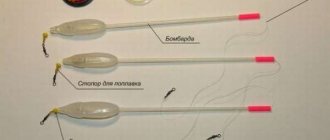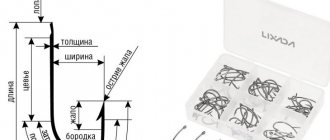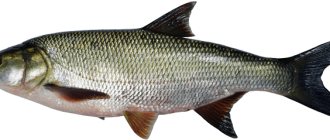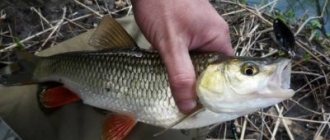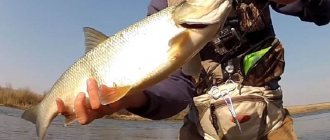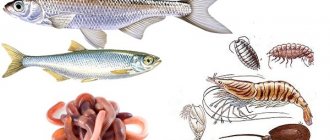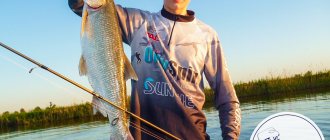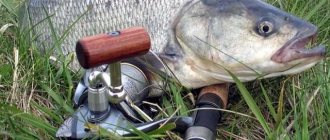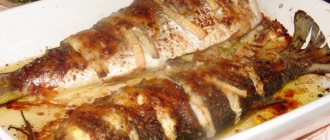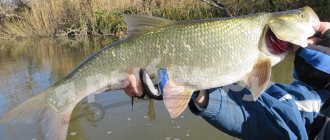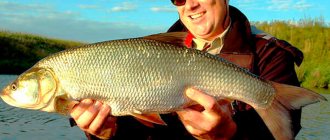According to some reports, the asp can grow, gaining weight up to 20 kg. However, very rarely there are individuals weighing about 12 kg, and most of them are asp, which grows up to 8 kilograms. Most likely, this is due to the fact that he simply does not have time to grow to such a size.
Asp is a fish that belongs to the family of carp species. Anyone who has caught an asp knows how strong he is. Sometimes, when biting a large asp, you have to demonstrate all your skill and all the experience accumulated over the years in order to catch this fish. There were legends about how powerful this fish was.
This article contains a lot of interesting and useful information for those who are mastering asp fishing. This activity will require not only the ability to use tackle, but also knowledge of the behavior of this strong fish. To catch him you need to know certain points, which include:
- where do they catch asp?
- when they catch an asp;
- what baits are used to catch asp;
- What gear can you use to catch an asp?
Asp habitats. Where to look for asp?
The asp is very popular among fishermen, and they catch it with great interest and excitement.
Mostly the asp prefers to choose lowland rivers with a calm current for living, but it can often be found in lakes, as well as reservoirs that are artificially formed during the construction of hydraulic structures.
In warm seas, this fish leads a semi-anadromous lifestyle. In fresh water it prefers to feed on bleak.
The best time of year for asp fishing
The most optimal time of year for asp fishing is early June and until autumn.
It is during this period that it is easiest to catch a large specimen, and the chances of catching at least something also become greater.
In principle, you can start trying from the moment the snow melts, but it should be borne in mind that when the water temperature still fluctuates at a low level, the fish hunts at depth, and not at the surface, so it is more difficult to distinguish the feeding areas of the asp, which complicates the process.
In summer, the water warms up, and he begins his hunt for prey in the upper layers, near the surface of the water, so that even the naked eye can see and hear it;
Closer to autumn, when the temperature begins to drop, it goes deeper and deeper again.
Seasonal fishing features
The asp is a fast predator that loves clean water saturated with oxygen. The basis of its diet is small fish - bleak, perch, dace, juvenile roach, chub and ide. In summer, he supplements his menu with insects that fall into the water. In cold weather, it feeds on bottom invertebrates and crustaceans.
Each period of the year leaves its mark on the behavior of the sheresper. The predator changes its location, habits, and food preferences. When setting up for asp fishing, it is necessary to take into account many factors, from wind strength to depth at the fishing site. Only in this way will the capture of the predator become regular in any weather.
Spring
In the spring, asp fishing can be divided into two stages - early spring and post-spawning. In March, before the start of spawning, predators need to be looked for in holes, channel dumps, and whirlpools. For this purpose, classic jig equipment, spaced rigs or diving crank-class wobblers are used.
Jig allows you to catch asp in early spring
In temperate latitudes, spawning of this representative of the ichthyofauna begins in the second ten days of April. Fish activity drops to zero. Then the bite resumes with renewed vigor in early May, as soon as stable warm weather sets in.
Advice! In spring it is better to go to large bodies of water. It is very difficult to catch an asp on small rivers during this period.
On large rivers, the Volga, Oka, Don and others, in the spring they look for asps in channels, branches and branches from the main channel. The predator rises to the upper horizons and quickly hunts for small fry that have accumulated near the surface. Sheresper, as in the summer, quickly crashes into a school of small fish, breaks it, and then picks up the unwary fish.
Summer
Summer is the brightest and most spectacular period in asp hunting. The predator feeds from the surface, powerfully attacking small fish. All bites occur literally in front of the spinning angler’s eyes, the fish offers decent resistance. Such dynamic fishing will be remembered for a long time.
In June and July, asp are caught mainly on spits away from the shore. They use heavy oscillating spoons with impressive flight characteristics. Since August, the sheresper begins to be interested in other types of bait, often descending into the middle layers, appearing on the edges and deep dumps.
On large rivers, the best summer bait for asp is a jig
Asp fishing in August is perhaps the most productive. The fish responds to jigs, wobblers, topwaters, and spinners. In the second half of the month, silicone baits mounted on regular jig heads of suitable weight begin to shoot periodically.
On many large bodies of water, a tendency has been noticed that in August large specimens are caught on spinning rods, and trophy specimens are often caught. The fish moves under steep slopes with sharp edges and drop-offs into the riverbed. Fishing along steep yars with trees that have fallen into the water is especially effective.
Top 6 most popular ways to catch asp
There are several types:
On Spinning;
Fly fishing;
Donkoy;
Using a float rod;
Floating;
Path.
Catching asp with a spinning rod. Tackle, technique and fishing tactics
You need to start first of all with choosing the spinning rod itself - this is one of the main components of success.
The length of the fishing rod must be at least 1.4 m and no more than 2.7 m. The very size of the reservoir in which the event is planned should be taken into account.
However, for beginners it is best to choose a stick at least 2.7 m long, since the specificity of a spinning rod is that the longer it is, the easier it will be for you to cast.
The second very important and basic aspect of fishing is casting accuracy.
To make the task easier, it is recommended to equip the reel with thin mono or braided fishing line.
The rod's rings should be of good quality, and it is preferable to use a spinning reel.
The diameter of the first throughput ring should range from 30 to 35 mm. Experienced fishermen strongly advise against purchasing hard rods or overly fast spinning rods.
The asp resists much more energetically when it gets hooked, so a rigid rod can break under its pressure.
Tactics and fishing techniques
Depending on the time of year, the specific fishing location and fishing habits, you can choose one of several tackles - fly fishing, spinning rod, float rod. Regardless of which gear you prefer, you need to know the subtleties to increase the likelihood of successful fishing.
Fly fishing
This option is justified at the beginning of summer, when the asp gathers in flocks and kills the fry. At this time, he does not disdain tasty insects. When choosing a suitable reel, give preference to lightweight models that can hold a lot of fishing line. There must be a reliable and comfortable brake - a second delay can cost a trophy. It is not necessary to take a long rod; even when fishing from the shore, 3-3.5 meters is enough. But it must be durable - if you are going to fish for such a strong fish as asp, you should not buy cheap Chinese crafts, the quality of which is questionable. It is important to choose the right fly - the color and shape correspond to the insects that are common near the reservoir. An unfamiliar bait will certainly scare away the asp.
To learn more:
Bite alarm with pager
Having arrived on shore, you need to develop a suitable plan of action. At the beginning of summer, the predator gathers in schools, driving the fry, and collective hunting is used, which shows the high level of intelligence of the fish. By finding a cauldron (a place where a school of asp drives the fry) and throwing gear there, you can count on a good catch. In such cases the bite follows immediately. If you can’t find the boiler, you need to cast the fly onto the rapids, and not into the active stream of the current, but to the border where the flow is not so rapid.
Many fishermen disagree on whether the asp takes the fly right away or waits until the current brings it under his nose. Try both options - let the bait move with the flow of water, without relaxing for a second - be prepared for a sharp hook.
Spinning
This gear is great for fishing in the warmer months and should be chosen seriously. Spinning for catching asp from a boat, boat and from the shore will be a good solution, and even the equipment will not be too different. The rod itself must be long - at least three meters, because you will have to cast the bait far. The optimal test is 50-70 g. It is better to take a spinning reel, although a multiplier one is also suitable if you have to fish from the shore or from a boat at the end of summer, when the asp becomes cautious.
There are no preferences in choosing fishing line. Monofilament, braided - depends on habits. The optimal diameter is 0.2-0.3 mm. This fish does not have sharp teeth like pike perch or pike, and a metal leash is not needed. As bait for catching asp, it is advisable to have several baits on hand - the preferences of the predator change sharply and unexpectedly. A spoon that caught a great bite a week ago may turn out to be useless today.
The castmaster for asp is popular - due to its large weight, it can be thrown over a considerable distance. Bombarda, known as sbirulino, performed well. A large float pulls the bait, which in strong currents and shallow depths jumps over the rocks, like a fish looking for edible insects. The asp probably won't resist. Vladimir Struev talks interestingly about this bait in the video below.
Experienced fishermen do not forget proven spoons. A spoon weighing 30-45 g helps out in cases where other baits are useless. A small wolfer can also be a good choice.
To learn more:
How to make a girder for pike
You should approach fishing carefully. For example, when hunting for pike, fans of spinning rods try fishing through different layers of water. If the target is an asp, it makes sense to give preference to the upper and middle wires - he rarely hunts below. Therefore, after casting the bait, either start retrieving it immediately or after a second so that the spoon or castmaster does not have time to lie on the bottom.
Asp is an extremely smart and cautious fish, which is noticeable when catching large, trophy and therefore desirable specimens. When fishing from a boat, try not to swim closer than 60-80 meters to the casting point. The slightest noise or unfamiliar silhouette will scare the asp, and then fishing will not be as successful as we would like. That’s why catching asp with castmaster and heavy spoons is so popular among masters – they are cast over a long distance. Of course, in such cases it makes sense to choose braided fishing line. It is lightweight and allows you to make long casts.
Float rod
Asps are caught relatively rarely with this tackle, although there are such masters. They can be understood - cautious fish rarely bite the bait, but the process of catching even a kilogram specimen will bring a whole range of feelings. It is not advisable to use a fishing line thicker than 0.3 mm - this will scare away wary fish. But if a specimen weighing 5-7 kilograms is tempted by the bait, it will not be easy to pull it out.
The fishing rod should be long - at least 3.5 meters, and preferably more. There are no special requirements for it; it is better to take the most convenient one. Inertia-free will allow you to make long casts and eliminate the possibility of the line getting tangled. Finally, the float. It’s better to take a transparent one - it’s almost invisible, which means it won’t attract unnecessary attention. True, these are not always available for sale, so some craftsmen use homemade floats.
When casting, try not to get too close to the water; stay against the backdrop of bushes and not in open areas. A strong, brave, but cautious asp, having noticed the shadow or silhouette of a fisherman, may well go to another place. That is why it is better to choose a long fishing rod - you can cast bait without coming close to the coastline.
Advantages of spinning reels. 3 main advantages
Easy and smooth glide;
Many models have a system that ensures casting range (ABS or Long Cast);
The gear ratio should be in the range of 5.1/1, and the spool diameter should be from 3000–3500.
Based on the experience of many professional and experienced fishermen, we can conclude that thick wattle nets in asp fishing are not sufficiently effective, so it is recommended to change the large diameter to a smaller one - in the range from 0.14 mm to 0.16 mm.
Such parameters will be enough to fight this wayward fish and will not frighten you with its size.
6 asps in 7 minutes per castmaster (video)
Fly fishing for asp
How to fly fish?
For such fishing, a 8-class rod is usually enough, but a 9-class rod is also possible. If the asp’s bite is in the active stage, then it is caught using a floating line and streamers or dry flies.
If hunting takes place at half-water level, then the line should be sinking and the bait of the appropriate class.
The most effective place to use fly fishing is in the shallows. When catching asp in this way, they usually use:
Various flies, grasshoppers and streamers of different colors;
The cockchafer is also well suited for such purposes;
Of the artificial flies, it would be optimal to use dry flies in a light color scheme.
In order to catch an asp in this way, it is important to choose the right equipment:
The cord must be floating or intermediate, and the undergrowth must be 2 to 4 m long;
Unlike spinning fishing, the fishing line should be thicker so that when the fish grabs the bait, it does not break.
Once the gear is selected, you can start fishing. To do this, having chosen a convenient place, you should throw the wire with flies across the current and hold them lightly. During the process, you can tighten the cord at different paces.
When fishing occurs in river flow conditions, it is necessary to pull the bait towards you, and if it occurs in standing water, then the pull should be carried out slowly.
Fly fishing for asp on the Dubossary reservoir (video)
Asp: description and behavioral characteristics
Asp is a species of fish from the carp family, one of the favorite types of prey for many fishermen. To some extent, it is a unique representative of its family, since, unlike most related breeds, it is absolutely omnivorous: the asp feeds equally successfully on both plant and animal foods.
He received all his nicknames, for example, grip or horse, for his wayward, lively character, ability to develop high speed and make unimaginable jumps from the water. This predator is also distinguished by such character traits as cunning and caution. It has very great power, so for a successful catch you need to have sufficient experience and a number of skills.
Adults usually grow to a size of about 50 cm with a body weight ranging from 1.5-3.5 kg. However, these parameters are not limited; it is often possible to catch an asp with a body length reaching almost 100 cm and a body weight of 8-12 kg.
Externally it looks like this:
- The back is green-gray or monotonous gray.
- The tail and fins on the back are always gray.
- The hind and pelvic fins stand out on the body with a bright red color.
- The sides are covered with grayish-silver scales. The scales themselves are very small, which is an uncharacteristic feature for such a large representative of predatory fish.
- The body shape is oblong and elongated.
- Despite the fact that for the most part it is a predatory fish, teeth are completely absent, however, this is fully compensated by the size of the mouth. The specific structure of the jaw allows not only to grab prey, but also to hold it firmly, which prevents possible escape attempts.
Small specimens are often confused with bleak or ide, as there are significant visual similarities between these varieties. Older and larger representatives acquire a more individual appearance and are difficult to confuse with other varieties.
Usually it prefers to hunt single small fish, but during the feast it often attacks entire schools. When making an attack, it quickly gains high speed and, crashing into the intended school, crushes its prey with its tail, after which it grabs the first fish it comes across with its mouth. This is what determines the fact that the asp very often jumps out of the water - this means that at the moment he is in the process of hunting for a cluster of his victims. This tactic was popularly called combat.
Despite all these characteristics and aggressive hunting tactics, the predator under discussion is one of the most cautious fish living in fresh waters, and it is for this reason that it is extremely difficult to catch. In order to return with a catch, you will need to show not only your class in the fishing process, but also have a high level of camouflage skill.
Does not live in schools, as it is a solitary fish. However, sometimes in the summer, when there are a lot of bream or roach fry in the rivers, these predators still gather in schools, albeit small and temporary. This non-standard behavior means only one thing - the time has come for a group hunt for large flocks of fry.
Asp baits. Top 5 best baits
There are several types of bait that are most effective for catching this type of fish.
Devon is the most complex bait, which is very difficult to make on your own and difficult to find in a store in terms of price and quality.
When choosing this bait, you need to consider several points:
It should rotate easily;
Good weight in relation to compactness;
It is best to take a bait of this type made of lead;
High rotation speed. It should be noted that for solid Devons it is lower than for combined ones, the blades of which are made of brass or copper.
It is best to fish using the simultaneous use of baits, 2 types - left rotation and right rotation.
Trihedron - the purpose of this device is fishing in the water column at almost any depth. This is especially true in the spring and autumn.
Due to the fact that the trihedron seems to fall into the water, it is most popular among fishermen because of its efficiency. Most often, hunting with this bait can be found in the Middle Volga, where pike perch are also caught with it.
Castmaster is rightfully called a universal type spinner. With its help, asp can be caught in different ways.
For example, in the summer, when fishing mainly takes place in the upper layer of water, they use castmaster lures at high speed, and with the arrival of cold weather, they throw them to the depths and pull them up with steps.
If fishing takes place from a cliff, then with the help of this bait the spoon is pulled to the surface using a stepwise method, but at a careful and slow pace.
Jig - used for fishing in cold water. The use of this bait is used in a step-type method.
First of all, it should be taken into account that in the autumn and spring the asp usually feeds near the bottom and especially likes riffles, and it is in such cases that jigs are most effective. On such fishing you can catch a fairly large individual of this type of fish.
Wobbler - provides maximum opportunities with minimal restrictions.
For example, this bait is effective even if the asp does not show itself in any way on the surface of the water. Then you need to stand with the current and throw the gear across the current and slowly pull it up. This method is very effective.
Or another method. You should choose a place on the edge with a shallow depth - about 30 m from the spit and cast. A very effective bait and justifies itself in catching asp.
Bite at different times of the year
The asp pecks most actively after the mating season. Before spawning, it is sometimes possible to catch individual specimens using live bait or a worm. After spawning, the predator is so weak that if caught on a worm or larva, it does not even resist when pulled out.
When insects appear, they readily peck:
- on the May Khrushchev;
- dragonflies;
- gadflies;
- big flies;
In early June, the predator gains strength and begins to hunt in shallow water.
At this time, the fish actively go for the following baits:
- small live bait;
- floating wobblers;
- spinners;
- castmasters;
At the end of August, when fish hunt in schools, the predator will not allow the angler to come closer than 80 m; long-range artificial baits will be needed; the best option is a castmaster.
In autumn, the predator goes to the depths and bites only on live bait or deep-sea jig baits and wobblers.
Fishing methods
- You can fish with wobblers - these are the most popular long-range baits.
- You can fish with a spinning rod using a bombard, spinners, Devons, jigs, castmasters in summer and spring.
- Trolling fishing works well with floating wobblers, or in the fall in deep water and with jigs.
Tips for beginners. A few main rules on how to catch an asp
If a person has never gone fishing for asp, he will need to know at least the basic method of catching this fish.
The traditional method of catching asp is using a spinning rod. To do this, you will need to equip it with propeller-type spinners called “Devon”.
With this kind of gear you need to cast a little further than the spots where the fish splashes.
The asp swallows the spinner the moment it sinks into the top layer of water, so further actions require accuracy and speed.
In some cases, the fish swallows the “Devon” immediately, at a moment when the casting circles have not yet dispersed; at such moments, the asp begins to actively hunt for it and the illusion of a “game” is created.
After the fish grabs the bait, the line suddenly becomes tense, a jerk is felt at this very moment, you need to hook, but with great care, since either the line or the asp’s mouth may break.
When the fisherman is convinced that the fish is on the hook, the line must be lowered and slowly reeled in so that it can be carefully brought to the shore.
If the asp was hooked correctly, then its behavior is predictable - it will either try to go downstream or go to a depth opposite to the fisherman.
At this stage, it is important not to loosen the tension of the fishing line, since this type of fish is very shy and may try to break away several times, which will lead to the breaking of the fishing line or damage to its oral cavity.
When carrying out competent actions and following all the rules, the chances of successful fishing even for beginners increase several times.
Is it necessary to feed an asp?
Feeding asp is not particularly practiced, so there are no special recipes for this. However, taking into account the fact that he is a representative of predatory fish, in those rare cases when he is nevertheless fed, the appropriate animal ingredients are used.
Usually chopped worms or crayfish meat are mixed with boiled cereals, which attracts prey with its smell. The bait can be made in the form of small balls or placed in water in a special feeder.
